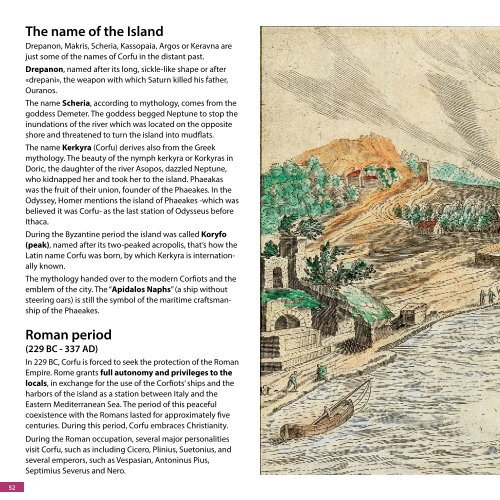Create successful ePaper yourself
Turn your PDF publications into a flip-book with our unique Google optimized e-Paper software.
The name of the Island<br />
Drepanon, Makris, Scheria, Kassopaia, Argos or Keravna are<br />
just some of the names of Corfu in the distant past.<br />
Drepanon, named after its long, sickle-like shape or after<br />
«drepani», the weapon with which Saturn killed his father,<br />
Ouranos.<br />
The name Scheria, according to mythology, comes from the<br />
goddess Demeter. The goddess begged Neptune to stop the<br />
inundations of the river which was located on the opposite<br />
shore and threatened to turn the island into mudflats.<br />
The name Kerkyra (Corfu) derives also from the Greek<br />
mythology. The beauty of the nymph kerkyra or Korkyras in<br />
Doric, the daughter of the river Asopos, dazzled Neptune,<br />
who kidnapped her and took her to the island. Phaeakas<br />
was the fruit of their union, founder of the Phaeakes. In the<br />
Odyssey, Homer mentions the island of Phaeakes -which was<br />
believed it was Corfu- as the last station of Odysseus before<br />
Ithaca.<br />
During the Byzantine period the island was called Koryfo<br />
(peak), named after its two-peaked acropolis, that’s how the<br />
Latin name Corfu was born, by which Kerkyra is internationally<br />
known.<br />
The mythology handed over to the modern Corfiots and the<br />
emblem of the city. The “Apidalos Naphs” (a ship without<br />
steering oars) is still the symbol of the maritime craftsmanship<br />
of the Phaeakes.<br />
Roman period<br />
(229 BC - 337 AD)<br />
In 229 BC, Corfu is forced to seek the protection of the Roman<br />
Empire. Rome grants full autonomy and privileges to the<br />
locals, in exchange for the use of the Corfiots’ ships and the<br />
harbors of the island as a station between Italy and the<br />
Eastern Mediterranean Sea. The period of this peaceful<br />
coexistence with the Romans lasted for approximately five<br />
centuries. During this period, Corfu embraces Christianity.<br />
During the Roman occupation, several major personalities<br />
visit Corfu, such as including Cicero, Plinius, Suetonius, and<br />
several emperors, such as Vespasian, Antoninus Pius,<br />
Septimius Severus and Nero.<br />
52



